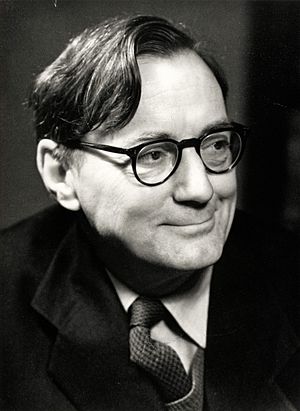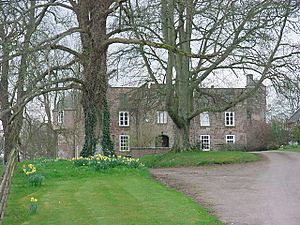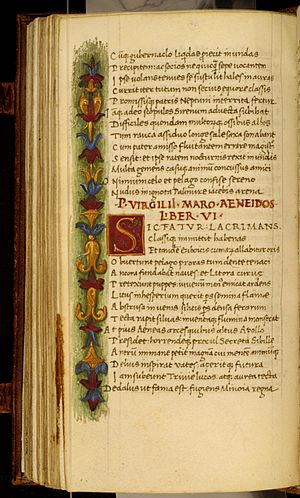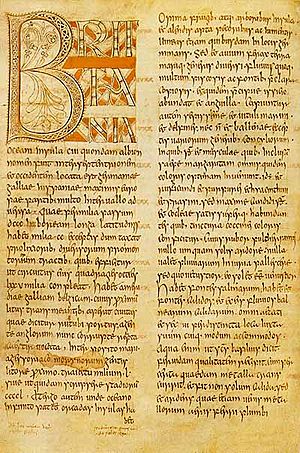R. A. B. Mynors facts for kids
Quick facts for kids
Sir
R. A. B. Mynors
|
|
|---|---|

Portrait by John William Thomas
|
|
| Born |
Roger Aubrey Baskerville Mynors
28 July 1903 Langley Burrell, Wiltshire, England
|
| Died | 17 October 1989 (aged 86) near Hereford, England
|
| Education | Eton College |
| Alma mater | Balliol College, Oxford |
| Spouse(s) |
Lavinia Alington
(m. 1945) |
| Awards | Knight Bachelor (1963) |
| Scientific career | |
| Institutions | |
| Influences |
|
| Influenced |
|
Sir Roger Aubrey Baskerville Mynors (born July 28, 1903 – died October 17, 1989) was an English expert in Classics (ancient Greek and Roman studies) and the Middle Ages. He held important teaching positions in Latin at both Oxford and Cambridge. He was known for studying old manuscripts and using them to understand ancient texts better.
Mynors worked for most of the 20th century at two of England's top universities. He went to Eton College and then studied at Balliol College, Oxford. He taught there for many years. From 1944 to 1953, he was the Kennedy Professor of Latin at Cambridge. Then, from 1953 until he retired in 1970, he was the Corpus Christi Professor of Latin at Oxford. He passed away in a car accident in 1989 when he was 86 years old. He was on his way to his family home, Treago Castle, in Herefordshire.
Sir Roger Mynors is considered one of Britain's most important classicists. He was an expert in palaeography, which is the study of old writing. He was very good at figuring out how different old books were related. He wrote important editions of works by famous ancient writers like Vergil, Catullus, and Pliny the Younger. He also worked on texts from the Middle Ages, such as those by Bede and Cassiodorus. He was part of the team that edited the complete works of Erasmus, a famous scholar. His last big project was a detailed study of Vergil's Georgics, which came out after he died. For his achievements, he was made a Knight Bachelor in 1963.
Contents
Early Life and School
Roger Aubrey Baskerville Mynors was born on July 28, 1903, in Langley Burrell, Wiltshire. His family, the Mynors, were well-known landowners from Herefordshire. They had owned Treago Castle since the 1400s, and Roger lived there later in his life.
His mother was Margery Musgrave. His father, Aubrey Baskerville Mynors, was a church leader and the rector of Langley Burrell. Roger had four brothers and sisters. One of them was his identical twin brother, Humphrey Mynors, who later became a high-ranking official at the Bank of England. The twin brothers were very close and lived together at their family home after Roger retired.
Roger went to Summer Fields School in Oxford. In 1916, he joined Eton College as a King's Scholar, which meant he got a scholarship. At Eton, he was in the same group as famous people like the historian Steven Runciman and the writer George Orwell. He became very interested in Latin literature and how old texts were passed down. Two of his teachers, Cyril Alington and M. R. James, really encouraged this interest. Alington became a close friend and mentor because he also loved the history of old books from medieval Europe.
University Career
Studying at Oxford

In 1922, Mynors won a scholarship to study Classics at Balliol College, Oxford. He did very well in his studies. He graduated in 1926 and won several important scholarships. He then became a fellow at Balliol, which meant he was a senior member of the college and taught Classics. In 1935, he became a University Lecturer. During this time, he often taught about the poet Vergil, whose complete works he would later edit.
While at Oxford University, Mynors began his important work on medieval manuscripts. From the late 1920s, he became more interested in codicology, which is the study of books as physical objects. He prepared an edition of the 6th-century scholar Cassiodorus. For this, he traveled a lot in Europe. His critical edition was published in 1937.
In 1929, he became the librarian of Balliol College. This job helped him create a list of the college's medieval manuscripts. He also worked on a similar project in the 1930s, making a list of manuscripts at Durham Cathedral. His interest in old books led him to work closely with other medieval scholars like Richard William Hunt and Neil Ripley Ker.
In 1936, Mynors met Eduard Fraenkel, a Latin professor at Oxford. Fraenkel had moved to England because of the unfair treatment of German Jews. He was a leading expert from Germany. Fraenkel helped Mynors become a professional expert in Latin texts. They remained close friends, and Mynors met other German scholars through him.
In 1938, Mynors was a visiting scholar at Harvard University. When World War II started, he worked for the British government, managing foreign money. He taught at Balliol from 1926 to 1944 and guided many future scholars.
Moving to Cambridge

In 1944, Mynors accepted a job as the Kennedy Professor of Latin at the University of Cambridge. He also became a fellow of Pembroke College. In 1945, he married Lavinia Alington, who was a medical researcher and the daughter of his old teacher, Cyril Alington. They did not have children.
Moving to Cambridge was a step up in his career. However, he soon thought about returning to Oxford. He tried to become the head of Balliol College in 1949 but was not chosen.
His job at Cambridge changed his academic focus. At Oxford, he mostly taught students and did his own research on old writing. At Cambridge, he had to give many lectures on Latin literature and guide research students, which was new to him. These duties left him little time for college activities. He later said that moving to Cambridge was a "fundamental error" for him.
Even though his main job was about Latin, he became more involved in publishing medieval texts during the 1940s. He became an editor for Nelson's Medieval Texts series in 1946. He edited the Latin text for many books in this series. He was the main author of editions of Walter Map's De nugis curialium and Bede's Ecclesiastical History. In 1947, he worked with the Oxford historian Alfred Brotherston Emden.
Back to Oxford
In 1953, Mynors was appointed Corpus Christi Professor of Latin and could return to Oxford. He took over from Eduard Fraenkel. This was unusual because professors rarely moved between such important positions at Oxford and Cambridge. Most of his work on editing Latin texts happened during this second time at Oxford.
He worked for the Oxford Classical Texts series. He created important editions of the complete works of Catullus (1958) and Vergil (1969). He also edited Pliny the Younger's Epistulae (1963). Even though he focused on classical subjects, he continued to work with manuscripts as a curator at the Bodleian Library. During his 17 years at the college, Mynors worked to keep it a top place for Classics. He also connected with a new group of Latin scholars.
Retirement and Death
In 1970, Mynors retired from teaching and moved to his family estate at Treago Castle. He spent a lot of time planting and caring for trees. During his retirement, he also worked on a detailed study of Vergil's Georgics, which was published after he died in 1990. He translated the letters of the famous scholar Desiderius Erasmus. He was also interested in the nearby Hereford Cathedral, serving as the chairman of the Friends of the Cathedral from 1979 to 1984. In 1980, a fund was set up in his name to buy rare books for the cathedral.
On October 17, 1989, Mynors died in a car accident near Hereford. He was on his way back from working on the cathedral's manuscripts. He was buried at St Weonards. Meryl Jancey, the cathedral's Honorary Archivist, said that Mynors had been happy that day about his work on Bede's death. He told her he was glad he had translated the story of Bede's death, and that Bede had worked for God until the very end.
Contributions to Scholarship

Cataloguing Old Books
Mynors was most interested in palaeography, which is the study of old handwritten books. He was very good at figuring out how different old books were connected. He did this for his lists of books in the Balliol and Durham Cathedral libraries. He paid close attention to the physical details of the manuscripts, like ink blots and lines. This shows how much importance he placed on the look and feel of these old books.
Important Editions
Mynors created many important editions of Latin authors. He was known for being a "conservative textual critic." This means he was careful not to change the original text too much. He believed that old manuscripts and the people who copied them (scribes) had great historical value.
His first important edition was of Cassiodorus's Institutiones, the first new one since 1679. In his introduction, Mynors shared new ideas about the complex history of the manuscripts. This edition was highly praised by other scholars.
In 1958, Mynors published an edition of the poems of Catullus. He was very careful with Catullus's text and only made changes if there were clear errors from the scribes. He also decided to use normal Latin spelling instead of the older, more traditional spelling found in the manuscripts. This was seen as a very sensible choice. Reviewers noted that his edition carefully examined many old manuscripts that had not been looked at before.
His edition of Pliny's Epistulae used a similar method. Mynors's edition of Vergil's complete works updated an older text from 1900. He used more manuscripts, including 13 smaller ones from the ninth century, and added an index of names. His careful judgment of these smaller manuscripts was seen as a major strength. For Vergil's epic poem, the Aeneid, Mynors made a few changes based on modern ideas, even though he was usually very cautious.
Mynors also created a new text of Bede's Ecclesiastical History with historian Bertram Colgrave. He used an 8th-century manuscript called the Saint Petersburg Bede, which was unknown to earlier editors. This allowed him to create a new version of the text. Even though he didn't add detailed notes, his study of the text's history was praised as "clear" and "excellently done."
Legacy
During his career, Mynors became known as "one of the leading classical scholars of his time." Other scholars praised his work on texts. The Latinist Harold Gotoff called him an "extraordinary scholar." His editions of the poets Catullus and Vergil from Oxford are still considered the standard editions today.
Honours
Mynors became a Fellow of the British Academy in 1944. He was made a Knight Bachelor in 1963, which means he received the title "Sir." He also received honorary fellowships from Balliol College, Oxford (1963), Pembroke College, Cambridge (1965), and Corpus Christi College, Oxford (1970). The Warburg Institute also honored him.
Mynors was an honorary member of several important groups, including the American Academy of Arts and Sciences and the American Philosophical Society. He received honorary degrees from the universities of Cambridge, Durham, Edinburgh, Sheffield, and Toronto. In 1983, on his 80th birthday, a book called Texts and Transmission: A Survey of the Latin Classics was published to honor his work. In 2020, an exhibition was held at Balliol College to celebrate his studies of the college library.

